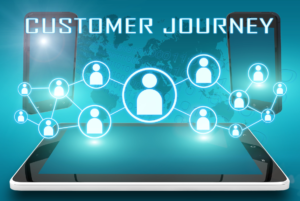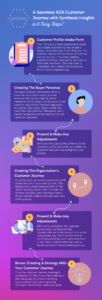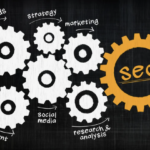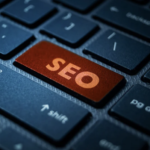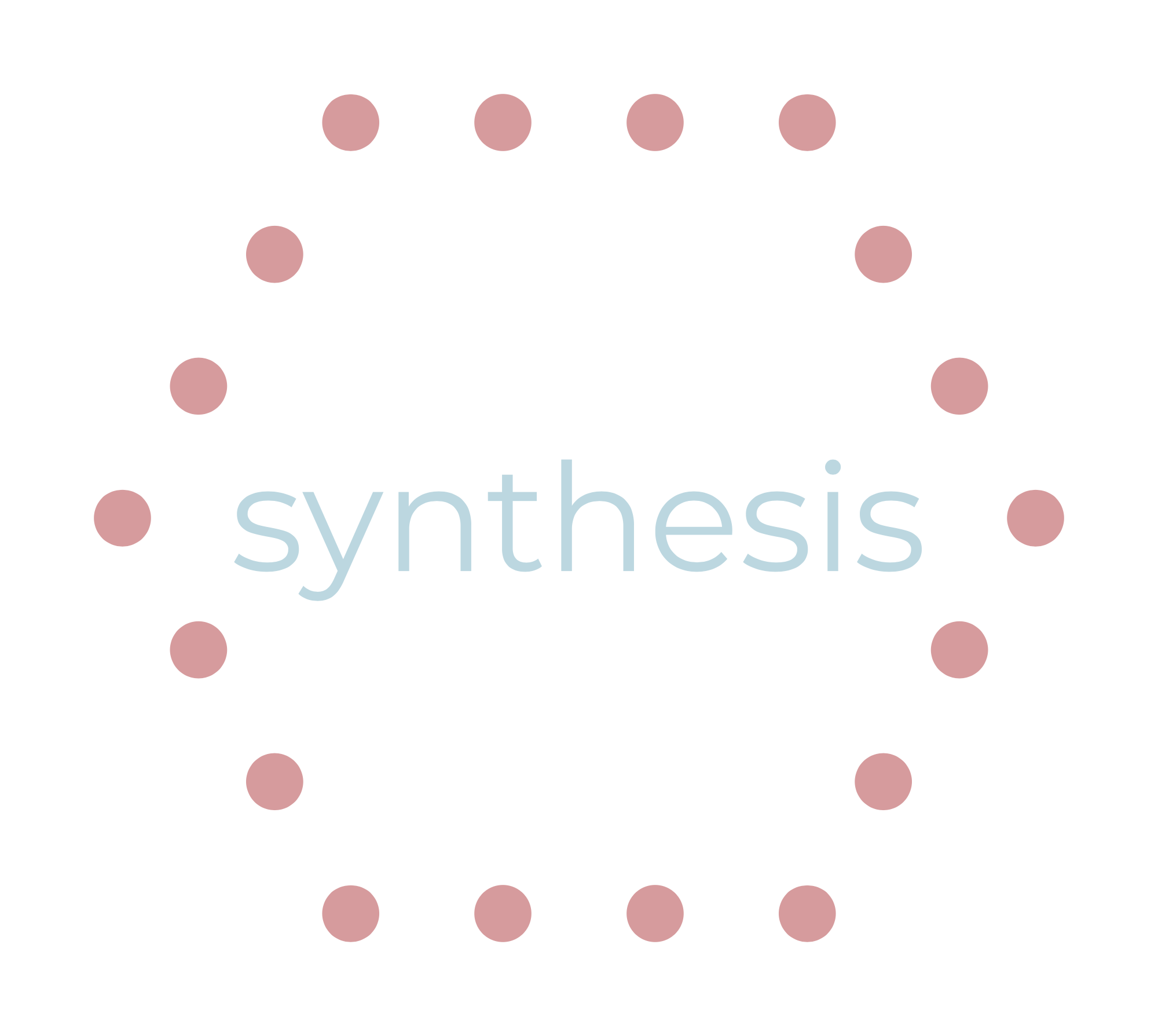Have you considered a customer journey for your B2B business to improve marketing efforts? Well, I’m here to tell you exactly what to expect from beginning to end. But first, make sure you read our post on B2B buyer personas (aka, “customer personas”) as this will be the starting point in this process.
If you’re in marketing, chances are you may have worked with an external agency. Maybe you were kept hidden in the dark? Perhaps you weren’t told what your step-by-step experience would look like?
Nowadays, transparency is everything, and it could be a dealbreaker (and a loss in business) if you can’t instill confidence in your clients. Below, I’ll take you through our customer journey experience and give you an idea of what you should expect from us and other B2B companies moving forward.
Let’s get started!
Contents
- B2B Customer Journey vs. B2C Customer Journey
- The Importance Of A B2B Customer Journey
- Our Customer Journey Process
- Step 1: Customer Profile Intake Form
- Step 2: Creating The Buyer Personas
- Step 3: Client Feedback On The Buyer Personas
- Step 4: Creating the Organization’s Customer Journey
- Step 5: Presenting The Customer Journey To The Client
- Step 6: Client Feedback On The Customer Journey
- Bonus: Creating A Strategy With Your Customer Journey
- Conclusion
Before we go through the various stages of the customer journey here at Synthesis Insights, let’s consider these key concepts that will give you a better understanding of the customer journey process and its importance when creating effective marketing strategies.
What Is A Customer Journey?
A customer journey (aka, “buyer journey”) is a series of connected experiences showcasing a buyer’s mindset and behavior through the main 3 stages of the purchasing process. In this case, we’ll be looking at the customer journey process from a B2B (“business-to-business”) perspective.

The 3 Purchasing Stages of a Customer Journey:
1. Awareness Stage: The prospect becomes aware that they have a problem.
E.g. Why is my marketing team struggling to meet deadlines?
2. Consideration Stage: The prospect defines their problem and considers available methods or solutions to solve it.
E.g. How do I alleviate my team’s workload and reduce stress?
3. Decision Stage: The buyer evaluates and decides what strategy, solution, or method they’ll ultimately use to make their final purchase.
E.g. Which marketing agency in San Diego can I work with at a reasonable cost?
Of course, this is only a simple explanation of the customer journey experience. There are many important questions and things to consider during the purchase process.
It’s important to note that the 3 main stages of the buyer’s journey will stay the same no matter what business you work with. However, according to Qualtrics, each business will have its own process of how the journey will play out from beginning to end, which you will also see in our journey process.
B2B Customer Journey vs. B2C Customer Journey
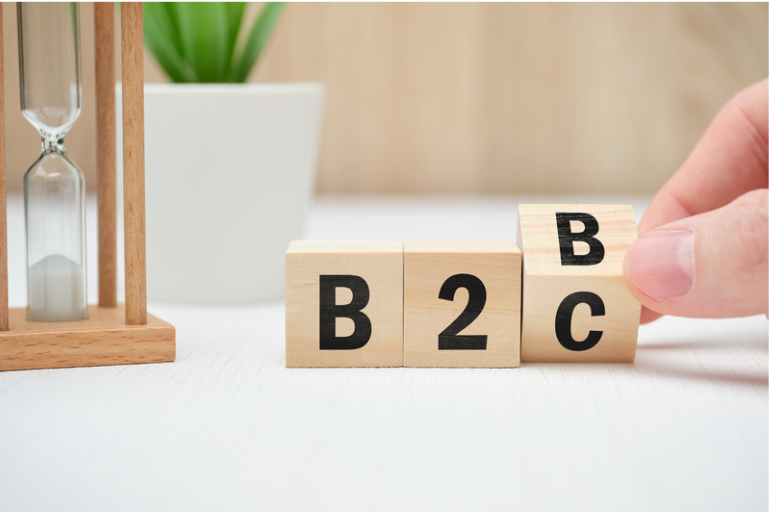
To develop the most appropriate journey, it’s important to know the differences between a B2B and B2C customer journey experience.
In a B2B (“business-to-business”) customer journey, the sales process involves convincing another organization or its decision-makers to purchase your products or services from you. The relationship between these organizations will be formed over a longer period of time, as multiple parties (i.e. departments within each organization) are involved and require collective input before completing the commercial transaction.
A B2C (“business-to-consumer”) customer journey, however, requires directly convincing a person (i.e. the end-user) to purchase your products or services. The relationship between the seller organization and the consumer will typically form within a shorter period of time, as the organization has its set products or services it’s readily offering and the consumer does not need to consult anyone else before completing the transaction.
B2B and B2C businesses can both find customer journeys helpful in guiding their marketing strategies and instilling confidence in their clients. However, each experience will differ depending on 1) whether the customer is an organization or a person, 2) the amount of time it takes to develop a relationship between the business and the client, and 3) the period of time in which it takes to execute the customer journey from beginning to end.
Since we’re focused on the B2B buyer experience, let’s discuss the importance of implementing a customer journey map and how it benefits both the business and the clients it’s helping.
The Importance Of A B2B Customer Journey
Why is the B2B customer journey important? According to Oro, buyers expect a smooth customer experience (CX) but find that there is a lack of personalization (39%) and self-service options (24%) that many companies fail to deliver on.
In order to provide your buyers with a smoother customer experience, it’s important to create a guide for the following reasons:
1. Instills confidence in potential customers.
Customers want to know that you understand their needs and have carefully crafted a product or service specifically for them.
2. Provides marketing opportunities to improve the way you are communicating with your buyers.
A customer journey uncovers gaps in messaging, creates content creation opportunities, and provides a clear roadmap for how to go to market with your product or service. Additionally, journeys are a way of providing consumers with transparency and showcasing what and how many steps will be included in the buying process (i.e. avoid any hidden steps).
3. Acts as a consistent roadmap to ensure all goals and stages are met.
Without a customer journey acting as your roadmap, it can be very easy to adopt new and exciting marketing strategies that don’t necessarily align with your goals. When you have a visual representation of how your marketing strategies will be executed, it’s a lot easier to stay on track and efficiently perform to meet your goals.
Now that we’ve covered the important groundwork for developing a customer journey roadmap, I’ll show you how we utilize our customer journey roadmap in order to advance our marketing strategies and reach our goals here at Synthesis Insights.
Our Customer Journey Process
Before you start creating your own customer journeys for your clients, remember that although every buyer will go through the awareness, consideration, and decision stages, the process of gathering data, creating buyer personas, and implementing customer journeys, etc. will vary from business to business. At Synthesis Insights, we like to start by getting to know our clients on a deeper level to provide them with the strongest output and the best possible purchasing experience.
Step 1: Customer Profile Intake Form

It’s essential that our client fills the form out as best as they can, as the output will only be as strong as the information provided. If the client has multiple customer profiles, they will need to complete a separate form for each profile.
Questions on the form include asking about demographics and background information, goals and motivations, challenges, marketing messaging, and communication preferences. If the client is unsure about their answers, we’ll use various digital channels such as web analytics data, CRM data, and social media data, or even conduct surveys/focus groups to complete the form.
After the client completes the form, they will return the form to us and we’ll review it to ensure that the information is clearly represented. We’ll also ask the client any additional questions if needed. We want to provide the best possible service and increase customer satisfaction, so there’s no time to be shy. We want to help!
Step 2: Creating The Buyer Personas
Once we’ve gathered all the information we need, it’s time to develop the buyer personas. Our team will input information directly from the customer profile intake form onto an easy-to-read template that can be used for future reference. Then we’ll choose a profile picture (or ask our client to provide a royalty-free photo) that best represents their ideal buyer(s). This will help them envision who they’ll interact with and remind them to align their marketing strategies with their unique customers. We’ll also give the avatar a creative name that will represent their target customer or use a description that best suits the customer profile.
When the buyer persona is completed, we’ll review it for any spelling, grammar errors, or missed information before sending it to our clients for feedback.
Step 3: Client Feedback On The Buyer Personas

We’ll use this opportunity to fine-tune the customer profile and clarify any additional questions that came up during the input process. It’s essential that we dig deeper into sales objectives and challenges, as this is typically an area of opportunity. This stage will work more efficiently if presented as a discussion rather than an email.
Step 4: Creating The Organization’s Customer Journey

Once the buyer persona has been finalized, we’ll start creating the client’s customer journey roadmap that will showcase a visual representation of the client’s buying journey. We’ll indicate the mindset, behavior, and responses buyers should typically embody—first from identifying an issue or a problem to finally completing the transaction (as the solution).

After we’ve completed the customer journey map, similarly to the buyer persona, we’ll review it for any spelling, grammar errors, or missed information before sending it to the organization for feedback.
We’ll use this time to clarify any questions that our clients may have or ask them questions that may help us better represent their purchasing journey. This process also works best if presented as a discussion.
At this point, we have a fully functional customer journey that we can use to influence and improve all of our marketing decisions.
Bonus: Creating A Strategy With Your Customer Journey
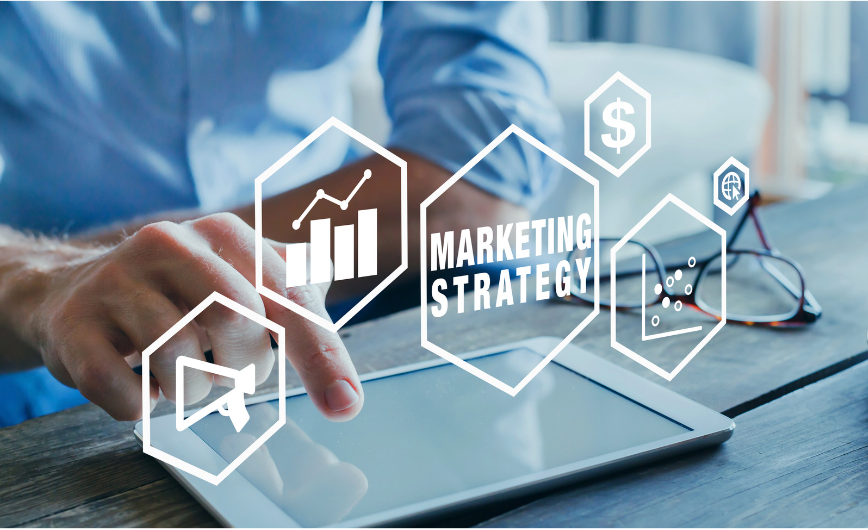
Once the customer journey roadmap is completed, it’s time to use the roadmap to take advantage of various marketing opportunities and create marketing strategies that will help reach your goals.
Now you’ll have a much better understanding of your customer’s needs and a clear roadmap for addressing their objections and concerns, which can be done by updating your content to match their journey. This could mean implementing B2B search engine optimization (SEO), a B2B blog strategy, B2B paid media, messaging, etc.
Whatever strategies you decide to use, make sure that it aligns with your goals and values and targets your unique audience.
Conclusion
Now I’d like to hear from you:
- What about the B2B customer journey concerns you when you interact with a business?
- Do you have any suggestions or concerns about our customer journey experience?
Provide your email address below to receive our complimentary customer profile intake form.

